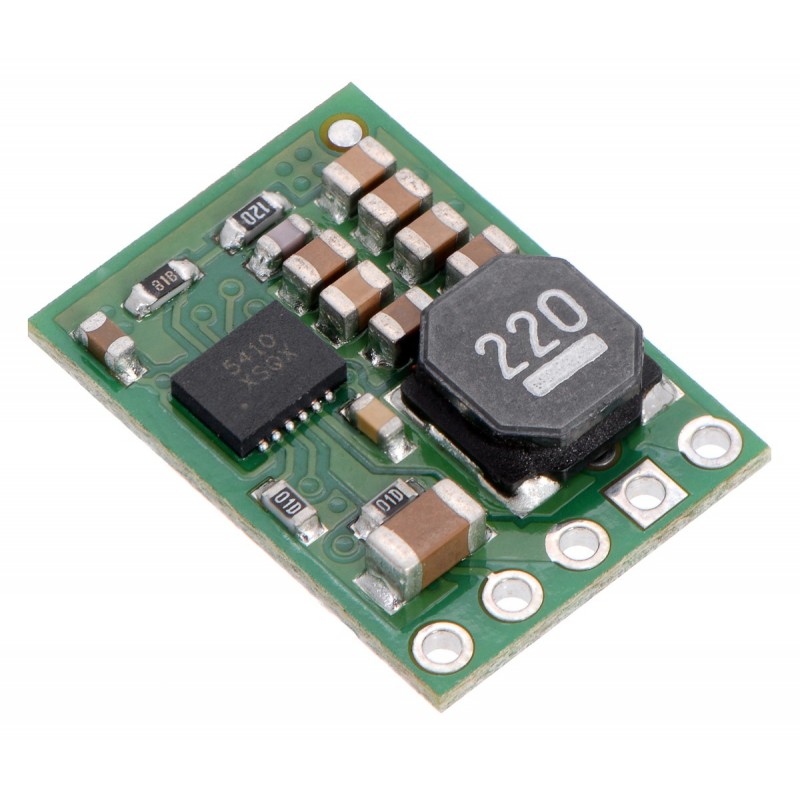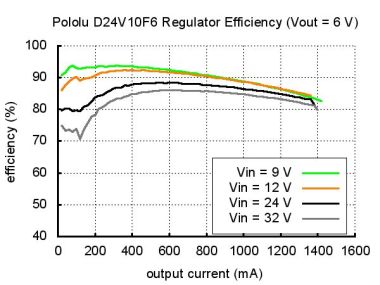

Pololu 6V, 1A Step-Down Voltage Regulator D24V10F6
The compact (0.5″ × 0.7″) D24V10F6 synchronous buck voltage regulator takes an input voltage of up to 36 V and efficiently reduces it to 6 V while allowing for a maximum output current of 1 A. This regulator offers typical efficiencies between 85% and 93% and has a very low dropout, so it can be used with input voltages as low as a few hundred millivolts above 6 V. The pins have a 0.1″ spacing, making this board compatible with standard solderless breadboards and perfboards.
Description
The D24V10Fx family of step-down voltage regulators features the Intersil ISL85410 1A synchronous buck regulator and generates lower output voltages from input voltages as high as 36 V. They are switching regulators (also called switched-mode power supplies (SMPS) or DC-to-DC converters) with typical efficiencies between 80% and 93%, which is much more efficient than linear voltage regulators, especially when the difference between the input and output voltage is large. These regulators have a power-save mode that activates at light loads and a low quiescent (no load) current draw, which make them well suited for applications that are run from a battery.
The different versions of this regulator all look very similar, so the bottom silkscreen includes a blank space where you can add your own distinguishing marks or labels. This product page applies to all five versions of the D24V10Fx family.
The SHDN pin can be used to put the board in a low-power state that reduces the quiescent current to approximately 10 µA to 20 µA per volt on VIN, and a PG (power good) output can be used to monitor the state of the regulator’s output voltage.
The regulators feature short-circuit/over-current protection, and thermal shutdown helps prevent damage from overheating. The boards do not have reverse-voltage protection.
Features
Connections
The buck regulator has five connections: power good (PG). shutdown (SHDN), input voltage (VIN), ground (GND), and output voltage (VOUT).
The “power good” indicator, PG, is an open-drain output that drives low when the regulator’s output voltage falls below 80% or rises above 120% of its target output voltage. This output is also actively held low for the duration of the regulator’s 2 ms soft-start period and while the regulator is being disabled by the SHDN input or by over-temperature or over-current fault conditions. An external pull-up resistor is generally required to use this pin.
The SHDN pin can be driven low (under 0.4 V) to turn off the output and put the board into a low-power state. There is a 100 kΩ pull-up resistor between the SHDN pin and VIN, so if you want to leave the board permanently enabled, the SHDN pin can be left disconnected. While the SHDN pin is being driven low, the current draw of the regulator is dominated by the current through the pull-up resistor and will be proportional to the input voltage. (At 36 V in it will draw about 360 μA.)
The input voltage, VIN, powers the regulator. Voltages between 3 V and 36 V can be applied to VIN, but the effective lower limit of VIN is VOUT plus the regulator’s dropout voltage, which varies approximately linearly with the load (see below for graphs of dropout voltages as a function of the load). Additionally, please be wary of destructive LC spikes (see below for more information).
The output voltage, VOUT, is fixed and depends on the regulator version: the D24V10F3 version outputs 3.3 V, the D24V10F5 version outputs 5 V, the D24V10F6 version outputs 6 V, the D24V10F9 version outputs 9 V, and the D24V10F12 version outputs 12 V.
The five connections are labeled on the back side of the PCB and are arranged with a 0.1″ spacing along the edge of the board for compatibility with solderless breadboards, connectors, and other prototyping arrangements that use a 0.1″ grid. You can solder wires directly to the board or solder in either the 5×1 straight male header strip or the 5×1 right-angle male header strip that is included.
Typical efficiency and output current
The efficiency of a voltage regulator, defined as (Power out)/(Power in), is an important measure of its performance, especially when battery life or heat are concerns. This family of switching regulators typically has an efficiency of 80% to 93%, though the actual efficiency in a given system depends on input voltage, output voltage, and output current. See the efficiency graph near the bottom of this page for more information.
In order to achieve a high efficiency at low loads, this regulator automatically goes into a power-save mode where the switching frequency is reduced. In power-save mode, the switching frequency of the regulator changes as necessary to minimize power loss. This could make it harder to filter out noise on the output caused by switching.
Typical dropout voltage
The dropout voltage of a step-down regulator is the minimum amount by which the input voltage must exceed the regulator’s target output voltage in order to ensure the target output can be achieved. For example, if a 5 V regulator has a 1 V dropout voltage, the input must be at least 6 V to ensure the output is the full 5 V. Generally speaking, the dropout voltage increases as the output current increases. See the “Details” section below for more information on the dropout voltage for this specific regulator version.
Details for item #2832
The graphs below show the typical efficiency and dropout voltage of the 6 V D24V10F6 regulator as a function of the output current:

p1.jpg)
Specifications
Download
Data sheet
Manufacturer BTC Korporacja sp. z o. o. Lwowska 5 05-120 Legionowo Poland sprzedaz@kamami.pl 22 767 36 20
Responsible person BTC Korporacja sp. z o. o. Lwowska 5 05-120 Legionowo Poland sprzedaz@kamami.pl 22 767 36 20
This small synchronous switching step-down (or buck) regulator takes an input voltage of up to 36V and efficiently reduces it to 5V. The board measures only 0.7″ × 0.7″ yet delivers a typical continuous output current of up to 2.5A and features reverse voltage protection. Pololu 2858
DC-DC Step-Down Converter ME3116AM6G with an output voltage of 5 V, input voltage from 6 to 24 V and a maximum output current of 1 A. Dedicated to the M5Stack modules. M5Stack U125
Modular power supply with a power of 3 W, input voltage from 100 to 240 V and output voltage of 5 V. Designed for mounting on a PCB. Hi-Link HLK-PM01
DC-DC Step-Up converter U3V40F7 with an output voltage of 7.5 V, an input voltage of 1.3 to 7.5 V and a maximum output current of 4 A. Pololu 4014
Step-Down converter D36V50F6 with an output voltage of 6 V, an input voltage from 6.5 to 50 V and a maximum output current of 8 A. Pololu 4092
A power supply based on a DC-DC converter with a current capacity of up to 5.1 A. The input voltage can range from 5 V to 30 V, while the output voltage is adjustable from 0 V to 36 V. It has built-in WiFi communication. XY3605
This compact (0.4″ × 0.5″) switching step-down (or buck) voltage regulator takes input voltages between 4 V and 50 V and efficiently reduces them to a lower, user-adjustable voltage set by an on-board trimmer potentiometer. It has an output voltage range of 2.5 V to 7.5 V and a maximum output current of 600 mA.
No product available!
Step-Down converter D36V50F9 with an output voltage of 9 V, an input voltage from 9.9 to 50 V and a maximum output current of 7 A. Pololu 4094
No product available!
This small synchronous switching step-down (or buck) regulator takes an input voltage of up to 38 V and efficiently reduces it to 3.3 V. The board measures only 0.7″ × 0.7″, but it allows a typical continuous output current of up to 2.5 A. Typical efficiencies of 80% to 95% make this regulator well suited for powering moderate loads like sensors or small motors.
No product available!
The Step-Down D24V3AHV Buck Voltage Regulator module with adjustable output voltage in the range of 4-25V with a wide input voltage range of 4.5-42V and a maximum output current of 300 mA. Pololu 2102
Step-Down RT8272 converter with adjustable output voltage in the range from 5 V to 12 V, input voltage from 5 to 24 V and a maximum output current of 3 A
Step-Down DC-DC converter module based on the D36V6F3 system. Input voltage 4 ... 50V, output voltage 3.3V (max. 600mA). Polol 3791
The Step-Down D24V6F12 Buck Voltage Regulator module gives the output voltage of 12V with a wide input voltage range of 15-42V and a maximum output current of 600 mA. Pololu 2109
No product available!
This synchronous switching step-down (or buck) regulator takes an input voltage of up to 40 V and efficiently reduces it to 6 V with an available output current of around 15 A. Pololu 2882
No product available!
The Step-Up Buck Voltage Regulator module with output voltage of 3.3V and input voltage range of 1-3V and a maximum output current of 200 mA. STMicroelectronics EVAL4971
DC-DC Step-Down converter module AP63203 with an output voltage of 3.3 V, an input voltage of 3.8 to 32 V and a maximum output current of 2 A. SparkFun COM-18356

Pololu 2832
